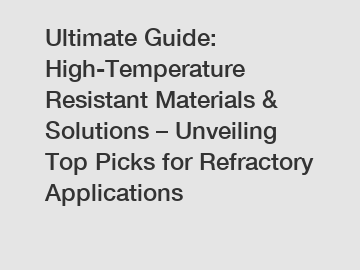Ultimate Guide: High-Temperature Resistant Materials & Solutions – Unveiling Top Picks for Refractory Applications
Ultimate Guide: High-Temperature Resistant Materials & Solutions – Unveiling Top Picks for Refractory Applications.
In industries that involve high-temperature processes, the challenge lies in finding materials and solutions that can withstand extreme heat without compromising performance or durability. Refractory applications, where materials are exposed to temperatures exceeding 1000°C, require specialized high-temperature resistant solutions to ensure safe and efficient operations. In this ultimate guide, we will unveil the top picks for high-temperature resistant materials and solutions, providing a comprehensive overview of their properties and applications.
1. Ceramic Fiber Products.

Ceramic fiber products are among the most commonly used high-temperature resistant materials in refractory applications. These products, such as ceramic fiber blankets, modules, and papers, are made from alumina-silicate fibers that can withstand temperatures up to 1600°C. Ceramic fiber blankets, in particular, are flexible and lightweight, making them ideal for insulation in furnaces, kilns, and other high-temperature equipment.
2. Refractory Bricks.
Refractory bricks are another popular choice for high-temperature applications. These bricks are made from high-quality materials, such as fire clay, silica, and alumina, that can withstand temperatures ranging from 1300°C to 1800°C. Refractory bricks are widely used in industries like steel, cement, and glass manufacturing, where they serve as linings for furnaces, kilns, and reactors.
3. Castable Refractories.
Castable refractories offer excellent versatility and can be used in various high-temperature applications. These materials are made from aggregates, binders, and additives, which are mixed with water to form a moldable refractory mass. Castable refractories are widely used for lining furnaces, boilers, and incinerators, providing excellent resistance to thermal shock and chemical attack.
4. Ceramic Coatings.
Ceramic coatings are a unique high-temperature resistant solution that can be applied to various substrates to provide protection against extreme heat. These coatings are made from advanced ceramics, such as alumina, zirconia, and silicon carbide, which form a dense and protective layer on the surface of the material. Ceramic coatings are used in industries like aerospace, automotive, and energy, offering thermal insulation, corrosion resistance, and improved durability.
5. Thermocouple Assemblies.
Thermocouple assemblies are vital components in high-temperature applications, as they provide accurate temperature measurement. These assemblies are made from temperature-resistant materials, such as ceramic, quartz, and refractory alloys, that can withstand extreme heat without affecting the readings. Thermocouple assemblies are commonly used in furnaces, boilers, and heat treating equipment to monitor and control temperature.
In conclusion, high-temperature resistant materials and solutions play a crucial role in refractory applications. The top picks for such applications include ceramic fiber products, refractory bricks, castable refractories, ceramic coatings, and thermocouple assemblies. Each of these materials offers unique properties and advantages, making them suitable for specific high-temperature environments.
To learn more about high-temperature resistant materials and solutions or to discuss your specific refractory application requirements, feel free to contact us. Our team of experts is ready to assist you in finding the best solutions to meet your needs and ensure the success of your high-temperature processes.
Contact us now to discover the right high-temperature resistant materials and solutions for your refractory applications!
For more Fireclay Brick Recipe, refractory mortar, castable refractory cementinformation, please contact us. We will provide professional answers.

Comments